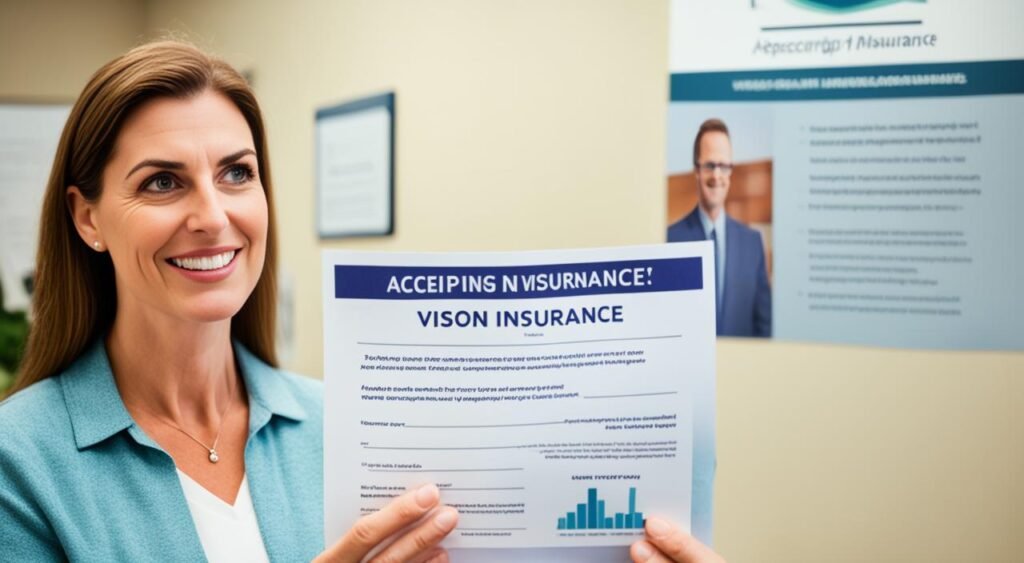Vision insurance is a special type of healthcare coverage. It helps you pay for things like eye exams. It can also cover glasses, contacts, and even LASIK surgeries.
Almost 79% of adults in the United States need vision correction. Having a vision insurance plan is very useful. It helps protect your eyes and saves money on vision care.
With vision insurance, you pay a monthly or yearly fee. In exchange, the plan helps with the costs of eye care. You still might have to pay some costs, like copays or deductibles. But, this sharing of costs makes eye exams and glasses more affordable for many.
Key Takeaways
- Vision insurance helps cover the costs of routine eye exams, prescription eyewear, and sometimes even vision correction procedures.
- It is a common healthcare coverage option, with 79% of adults in the U.S. using some form of vision correction.
- Vision insurance plans typically require monthly or annual premiums, and include cost-sharing features like copays and deductibles.
- Vision insurance can help make vision care more affordable, especially for those who require regular eye exams and corrective lenses.
- Understanding how vision insurance works and the different plan options available can help individuals choose the best coverage to meet their vision care needs.
Introduction
Keeping our eyes healthy is vital for our well-being. It’s important to have eye check-ups regularly. This can find not just eye problems but also health issues like diabetes and glaucoma. Even if your vision seems perfect, it’s crucial to get your eyes checked.
Importance of Vision Care
Eye health is key for our everyday lives. It lets us see clearly, read, work, and enjoy activities. Getting eye exams can spot problems early, helping to stop them from getting worse. These check-ups might even find other health issues. So, they let us look after our eyes and our body.
Role of Vision Insurance
Vision insurance helps cover the cost of eye care. It includes things like eye exams and glasses. This means you can save money and keep your eyes healthy with the right vision health plan.
Also Read: What Is Life Insurance For Kids And What Are The Benefits?
“Regular eye exams are crucial for preserving our vision and detecting potential health issues. Vision insurance makes these important tests and treatments accessible and affordable.”
Vision insurance is really important for keeping our eyes in good shape. It acts as a safety net, making sure we can afford the eye care we need.
What is Vision Insurance?

Vision insurance is key for your healthcare. It’s a special insurance to lower eye care costs. It covers things like eye check-ups, glasses, and contact lenses. This helps people save money on these services.
Definition and Purpose
It’s a policy that helps pay for eye care. It makes these health services cheaper for you and your family. With coverage for eye check-ups, glasses, and contacts, it eases the cost of keeping your eyes healthy.
Types of Vision Insurance
There are two kinds: vision benefits plans and vision discount plans.
- Vision Benefits Plans: These are like regular insurance for your eyes. They cover a lot, including check-ups and eyewear. You might pay part of the cost.
- Vision Discount Plans: Instead of full coverage, these plans lower prices. You pay to get discounts on eye care. While not as protective as benefits plans, they cut your costs.
It’s important to understand both types to pick the best one for your vision care needs and wallet.
Also Read: How To Get Financial Aid For University Of Houston
How Does vision insurance Work?
Vision insurance is vital in reducing the costs of eye care. It covers key aspects, like premiums, cost-sharing, and choosing the right eye care providers. This includes understanding the roles of in-network and out-of-network providers.
Premiums and Cost-Sharing
Your vision insurance premium is a regular fee you pay. It lets you access benefits like eye exams and eyewear at a lower cost. Vision insurance also involves cost-sharing through copays and allowances.
Copays are set fees you pay during the appointment. This could be for an eye exam or new glasses. Allowances are the most the plan will pay for services or eyewear. This amount changes with each plan and what’s being covered.
In-Network vs. Out-of-Network Providers
Knowing the difference between in-network and out-of-network providers is key. In-network providers are those your insurance has a deal with. Going to these providers can save you money because the plan pays more of the bill.
Also Read: What Documents Are Needed To File A Car Insurance Claim?
Out-of-network providers don’t have a contract with your insurer. So, getting care from them might cost you more. The insurance company might not pay as much, making the process more complicated.
| Feature | In-Network Providers | Out-of-Network Providers |
|---|---|---|
| Costs | Lower out-of-pocket expenses | More expensive without insurance |
| Reimbursement | More straightforward process | It can be complicated |
| Negotiated Rates | Pre-set rates are in place | Rates can vary widely |
Understanding premiums and the differences with in-network and out-of-network providers is important. It helps you get the best from your eye care coverage.
vision insurance Coverage

Most vision insurance plans cover two main things: eye exams and prescription eyewear. This helps people keep their eyes healthy and their vision clear. It’s important for those who need glasses or contacts.
Routine Eye Exams
One important part of vision insurance is getting regular eye checkups. These exams look at the health of your eyes and check your vision. If you need glasses or contacts, the doctor can give you a prescription.
Many plans let you pay a set amount for these checkups. This helps make the cost more manageable for the plan holders.
Also Read: What Is Flood Insurance And What Does It Cover?
Prescription Eyewear
This type of insurance also helps with the cost of glasses and contacts. Depending on your plan, you might get help paying for the frames, lenses, or contacts. This lowers the amount you need to spend on your eyewear.
Remember, each vision insurance plan is different. Some may have certain restrictions. It’s smart to really know your plan’s details. This way, you can make the most of what it offers.
“Having vision insurance can lower the cost of eye care. It covers checkups and eyewear, which is key for those needing glasses or regular eye care.”
Vision Benefits Plans
There are two main vision benefits plans: Preferred Provider Organizations (PPOs) and Health Maintenance Organizations (HMOs). Knowing their differences helps you pick the right vision coverage for you.
Preferred Provider Organizations (PPOs)
PPO vision plans let you see any eye doctor in their network. You get lower costs for things like eye exams and glasses at these places. Even if you go somewhere not in their network, PPO plans still help a bit with costs.
Health Maintenance Organizations (HMOs)
HMO vision plans ask that you pick one main eye doctor to manage all your eye care. They only cover visits to specific eye doctors and specialists. While you pay less each month for these plans, costs for services can be higher. And, seeing a specialist or someone not in their network needs a referral.
Also Read: What Are The Benefits Of Having A Life Insurance Policy?
| Feature | PPO | HMO |
|---|---|---|
| Provider Selection | Policyholders can visit any in-network eye doctor or provider | Policyholders must choose a primary care vision provider and can only visit in-network eye doctors and specialists |
| Out-of-Network Coverage | Typically offers some coverage for out-of-network providers, but with higher out-of-pocket costs | No coverage for out-of-network providers, except in emergency situations |
| Premiums | Generally higher monthly premiums | Generally lower monthly premiums |
| Referrals | No referrals required to see in-network specialists | Referrals typically required to see in-network specialists |
When picking a vision benefits plan, think about what you need, what you can afford, and what you prefer. PPO plans offer more choice while HMO plans keep costs down. Weighing the benefits and drawbacks of each type can lead you to the best vision insurance for taking care of your eyes.
Vision Discount Plans

Traditional vision insurance plans pay a part of the costs for vision care. However, vision discount plans work differently. They give a discount on eye exams, eyewear like glasses and contacts, and other services. This is instead of insurance covering a bit of the cost.
Vision discount plans mainly help you save money on your out-of-pocket expenses. Even though they don’t cover as much as regular vision insurance, the deals make vision care cheaper. This can really help people and families if they can’t get or afford full vision insurance.
How Vision Discount Plans Work
With a vision discount plan, you pay either monthly or yearly. This lets you get discounts on eye services and products from a big network of providers. You can save from 10% to 60% on the full price. So, you pay less money from your pocket.
| Service | Regular Price | Discount Plan Price | Savings |
|---|---|---|---|
| Eye Exam | $120 | $80 | $40 (33% off) |
| Single Vision Glasses | $200 | $150 | $50 (25% off) |
| Contact Lens Fitting | $100 | $60 | $40 (40% off) |
Vision discount plans are not the same as regular vision insurance. They can save you a lot of money, but they offer less coverage. They might not pay for every service or piece of eyewear. Always think about your needs and compare vision insurance to vision discount plans to find what’s best for you.
“With a vision discount plan, you can save on the costs of routine eye exams, glasses, and contacts, making vision care more accessible and affordable.”
Choosing the Right vision insurance Plan
There are key points to think about when picking a vision insurance plan. Think about your eye care needs. Look at what the plan covers and the costs like premiums and copays.
It’s also good to know the differences between plans from work and those you buy yourself. This helps you find what’s best for you.
Factors to Consider
Start by looking at what you need for your eyes. Do you need regular checkups, glasses, or special care? Knowing this helps match the plan to your needs and budget.
The coverage level matters too. Find a plan with many eye doctors to choose from and good benefits for glasses. Also, look for plans that cover a lot of the costs for usual eye care. This makes sure your plan fits your vision care needs well.
Employer-Sponsored vs. Individual Plans
Plans from work usually cover more and cost less. They find good deals because many people are part of the plan. So, they might have a wider choice of doctors and better benefits. What your job offers might be a great fit for you.
Yet, plans you get on your own can be right for special needs or when a work plan isn’t an option. They let you pick a plan that exactly meets your budget and requirements. This can make your vision care more personal.
| Employer-Sponsored Vision Insurance | Individual Vision Insurance |
|---|---|
| Often more comprehensive coverage | More flexibility in plan selection |
| Leverages group purchasing power for better rates | Tailored to individual vision care needs and budget |
| Broader network of in-network providers | May be the only option for those without employer coverage |
| More generous benefits | Provides a personalized approach to vision coverage |
Think hard about what you need for your eyes. Consider how the plans differ. By doing this, you can pick a vision insurance plan that’s just right for you.
Enrolling in vision insurance

Signing up for vision insurance can change based on if you get it through work or on your own. With employer-sponsored vision insurance, you usually have a open enrollment period once a year. This is when you can change your benefits, like adding or changing your vision plan.
If you’re looking at individual vision insurance plans, you have the freedom to get enrolled whenever you wish. However, for big changes outside this period, like after you get married or have a baby, you can tweak your plan.
Open Enrollment Periods
Companies often set their open enrollment at the same time as other benefit updates. This makes it easier to look at your current vision plan, adjust it as you need, or start a new one if you didn’t before.
Qualifying Life Events
After missing the open enrollment with your employer-sponsored vision plan, you can still join or make changes. It’s possible if a big life event like marriage, child birth, or losing vision coverage elsewhere happens.
Changes to individual vision insurance plans aren’t tied to specific dates. You’re free to get a plan or adjust it whenever you want.
“Remember, understanding the enrollment process for your vision insurance plan is crucial to ensuring you have the coverage you need when you need it.”
Canceling or Changing vision insurance

Vision insurance is often a yearly deal. You usually need a big life change to cancel or alter it. It’s good to know how to do this to keep your eyes covered right.
Qualifying Life Events
Big events can let you change or cancel your vision insurance. For example, you might do this if you:
- Get married and join your spouse’s vision coverage
- Lose your current vision insurance because you changed jobs
- Have a baby and need to add them to your policy
- Move to a new area with different vision insurance options
You’ll often have to show you have new coverage before you quit the old one. Always check your plan’s rules and talk to your insurance company about how to do this smoothly.
Canceling Vision Insurance
After a big life change, you might need to cancel your vision insurance. You’ll have to talk to your insurance provider. They’ll tell you what documents you need to prove your life change. This process is aimed at helping you smoothly end your current vision coverage.
Changing Vision Insurance
If you want to switch your vision insurance plan or providers, you can usually do it during open enrollment or after a big life change. Your insurance company will help you understand how to do this right so that the coverage meets your eye care needs.
Knowing how to cancel or change your vision insurance is important. It helps you keep the right coverage and makes sure your eye health care doesn’t get interrupted.
Coordinating vision insurance with Health Insurance
Managing your healthcare includes balancing vision insurance with general health plans. Usually, vision insurance and health insurance work separately. Yet, they coordinate to offer full eye health coverage. This lets you protect your eyes without worrying too much about the cost.
Primary and Secondary Coverage
Is vision insurance your main coverage or extra support? It depends on your situation. With vision insurance as the main, it pays first. Your health insurance covers the rest. This order helps you use both plans fully, cutting your spending.
However, if health insurance is your main, it takes on vision costs at first. Then, vision insurance steps in to pay the rest. This setup ensures your eyes get the care they need, even if it isn’t the primary coverage.
- Get to know how your vision and health plans work together to protect your eyes well.
- Working out a plan with both insurances can save you money. It uses all your available benefits wisely.
- Always check your insurance details to see how they support your vision care. Knowing this helps ensure good eye health care.
“Organizing both your vision and health insurance is key for handling your overall health costs and getting the best eye care possible.”
Learning how vision insurance and health insurance complement each other is crucial. With this knowledge, you can choose the best primary coverage and secondary coverage. In the end, you get better vision care and improve eye health within your overall medical plan.
Cost Savings with vision insurance
Vision insurance can help save you a lot of money. It covers costs for things like eye exams, glasses, and contacts. This makes getting care more affordable for both individuals and families.
Long-Term Benefits
Vision insurance leads to benefits over time too. Eye exams can find health problems early, like diabetes and high blood pressure. This means better health results and less money spent later.
Vision Insurance vs. Out-of-Pocket Costs
- Vision insurance often means you pay a known cost for eye exams and eyewear.
- Not having vision insurance means paying a lot more for care, especially if you need it often.
- Having vision insurance can save you a lot over time, possibly thousands of dollars.
So, because of the money you save and the health benefits, vision insurance is really valuable. It helps keep your eyes healthy without breaking the bank.
family vision insurance plans insured by humana insurance company blue cross and blue shield . vision insurance plans for individuals offered by humana insurance company , plans are offered by humana individual vision plans , blue view vision , davis vision , humana health benefit plan and affordable vision insurance plans.
humana vision insurance coverage for routine eye exams eyemed vision care. benefits of blue insurance for individuals and families plans can help choose a plan based on your specific plan, texas residents, network access plan available in all states with customer service number.
Also Read: Car Insurance Claims- 15 Of The Most Bizarre Excuses Ever Filed
Conclusion
Vision insurance is important. It helps people and families pay for eye exams, glasses, and more. This kind of insurance lowers costs and keeps eyes healthy for a long time.
This article explained how vision insurance works. It talked about different plan types, what they cover, how to sign up, and using it with health insurance. Knowing this helps you pick the right plan for your needs and budget.
Having vision insurance, whether from work or on your own, is smart. It cuts down on eye care expenses and supports good eye health. This way, you and your family can keep your eyes in great shape without financial stress.
FAQs
Q: What is vision insurance?
A: Vision insurance is a type of insurance coverage that helps offset the costs of routine eye exams, prescription eyewear, and other eye care services.
Q: How does vision insurance work?
A: With vision insurance, you typically pay a monthly or annual premium in exchange for coverage that includes benefits such as eye exams, glasses, and contact lenses. Depending on your plan, you may also have a copay or deductible.
Q: What does vision insurance cover?
A: Vision insurance typically covers routine eye exams, prescription glasses or contact lenses, and sometimes even discounts on elective procedures like LASIK surgery.
Q: How do I choose a vision insurance plan?
A: When choosing a vision insurance plan, consider factors such as the network of eye care providers, coverage for specific services you need, costs like premiums and copays, and whether your preferred eye doctor accepts the insurance.
Q: What are the benefits of having vision insurance?
A: Having vision insurance can help you save money on eye care expenses, encourage regular eye exams for maintaining your overall eye health, and provide access to affordable eyewear options.
Q: How can I find a vision insurance plan that fits my needs?
A: You can find vision insurance plans by contacting insurance companies directly, using online comparison tools, or working with an insurance agent who can help you navigate different plan options and benefits.
Q: Does vision insurance also cover dental and vision services?
A: Some vision insurance plans may offer bundled coverage that includes dental and vision services, so it’s worth exploring these options if you are looking for comprehensive coverage.
Q: What is VSP in relation to vision insurance?
A: VSP (Vision Service Plan) is a well-known vision insurance company that offers a wide network of eye care providers and comprehensive vision coverage benefits.
Source Links
- https://www.bennie.com/blog/how-does-vision-insurance-work
- https://www.progressive.com/answers/vision-insurance-101/
- https://www.metlife.com/stories/vision-insurance/what-is-vision-insurance/





